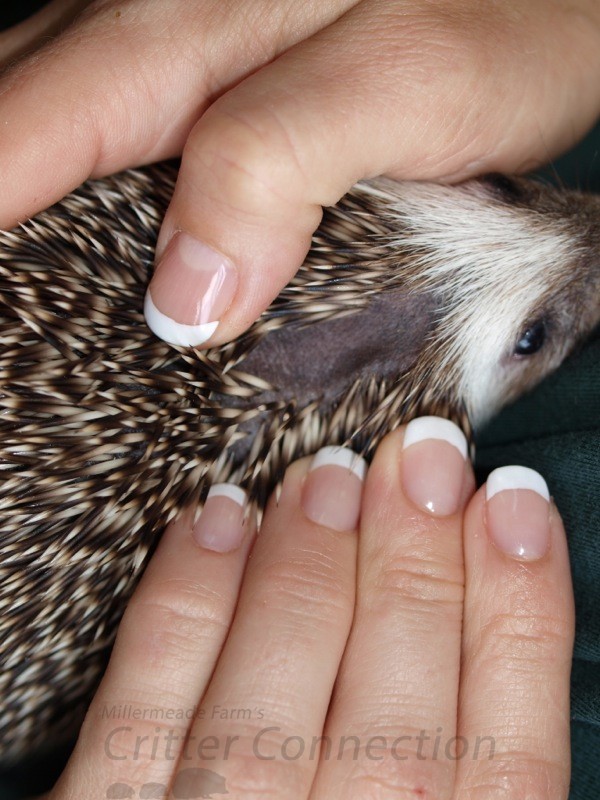Last Updated on November 6, 2022.
General Information
- The information below is not meant to scare you but to make you aware of this common problem.
- With proper diagnosis and treatment mites can be eradicated with little more trouble than a minor inconvenience.
- According to Heidi Hoefer, in Clinical Approach to the Pet Hedgehog, mites are the most important parasitic disease of pet pygmy hedgehogs.
- Most hedgehogs will encounter an Acariasis (mite) infestation at least once in its lifetime.
- Various hedgehog species in the wild are known to carry mites, fleas, maggots, and ticks.
- Almost all hedgehogs in the UK Hedgehog Rescues are treated for these little creatures.
- The only type of flea infestation affects only European hedgehogs in the wild.
- Dog and cat fleas typically do not infest African hedgehogs kept as pets in the US.
Symptoms
- Quill or Hair Loss
- Dry, Flaky, or Scaling Skin
- Scratching
- Caused by an uncomfortable feeling
- Excessive scratching is indicated by redness of skin and or scabs and sores
- Scratching can result in a secondary infection.
- Spines that are lost from the natural quilling process will have a root bulb that fits into the hair follicle similar to that of a human hair. o Spines that are lost due to mite infestation typically will have a soft, flaky appearance to the spine tip.
- Tattered or ragged ears
- Crust at the base of quills or around eyes and ears
- Scabs
Detection
- If you suspect that your hedgehog has mites the best thing to do is to seek treatment from a veterinarian.
- Some mites are visible to the naked eye or under a magnifying glass or reading glasses.
- In extremely severe cases the entire hedgehog may appear to be moving.
- They can be white (visible on the cages or bedding) or they can be dark brown or red.
- Other mites can be detected by rubbing your hedgehog with a black or deep blue piece of cloth until you get some of the flaky skin off. Hold the cloth under a bright light and use a magnifying glass to watch for movement.
- Even though you don’t see mites or mite movement you still may have a mite problem. A veterinarian will need to do a skin scraping (akin to scraping a knee with minor bleeding).
- The mites live on the skin tissue itself and tunnel through the skin. (Scea).
- They do not jump like fleas, they crawl and are much bigger.
- Scrapings need to be taken NOT from the center of a bald area, but from the side, red, irritated areas. The bald spots are empty of mites – that area has been “used up’ of viable tissue and the mites have moved on to fresher, more nutritious skin areas. (Scea).
- Low numbers of burrowing mites may not be detected with the first scraping so several scrapings on different parts of the body are recommended.
- Veterinarians may anesthetize your hedgehog to help your hedgehog become move relaxed when doing a skin scraping without additional stress to the hedgehog.
- Veterinarians will carefully remove the top later of skin to try and find burrowing mites.
Secondary Infections
- Hedgehogs can develop a secondary bacterial infection due to mite damage and may need additional antibiotic treatment.
- Untreated or out of control mites can cause
- Severe quill loss
- Red, inflamed skin with open sores
- Blindness
- Ear infections
- Other secondary infections from a weakened immune system
- Itching so badly that they don’g eat or drink enough and can become dehydrated
- Death
How Hedgehogs Can Develop Mite Infestation
- Poor husbandry can contribute to and perpetuate mite infestation but cleanliness cannot prevent a mite outbreak.
- Mites can be contacted through mite infested bedding or be dormant in bedding. Bedding that is “mite free” from the manufacturer can be contaminated at distribution points such as warehouses or pet-stores.
- Hedgehogs don’t just get “hedgehog mites” they can get mites from other species as well including cats, dogs, and birds.
- Other animals in the home with hedgehogs can cross contaminate hedgehogs or humans who are not even aware they have been in contact with mites can spread mites.
- Hedgehogs can carry very small numbers of mites with no sign of problems. The mites become a problem only when the hedgehog is under another stress such as a move, a chill or minor illness and its natural immune system is weakened and the mites take advantage of the opportunity for infestation.
- Mites like the drug cortisone and will reproduce rapidly when it is used.
- Mites reproductive rates increase during cool weather and decrease during hot weather.
Types of Mites
- Sarcoptoidea or Sarcoptiform mite
- Chorioptes bovix. Chorioptic mange mite is the most common mite that affects hedgehogs
- This mite is often referred to as scabies and is contagious to other pets and humans.
- This can affect more than just hedgehog in a household.
- Luckily for us the mite cannot complete its life cycle on humans and dies within a few weeks but in the mean time humans can experience mite bites and itching (Woolf).
- This mite’s lifecycle is roughly 21 days.
- In animals, the female mite burrows into the skin to lay its eggs and will cause excessive itching and scratching.
- The scabies mite eggs hatch in a few days, grow into adults and begin laying their own eggs in about three weeks. (Woolf)
- It is highly contagious to other household pets and humans but it doesn’t live on humans who practice good hygiene but you might notice some itching and minor mite bites.
- The Sarcoptic mite causes crusty ears, quill loss, and uncontrollable itching in hedgehog.
- This mite is often difficult to diagnosis because it tends to burrow under the skin and is very active. Several skin scrapings (equivalent to scraping a knee) might be required to actually find a sample of the mite.
- Your veterinarian may also carefully examine bare skin between the quills to find pin-point mite bite marks. Secondary skin infections may make this task quite difficult and may need to be treated first.
- Cheyletiella mange
- This mange is sometimes called “walking dandruff” because of the heavy dandruff this mite produces.
- The mite is red and larger than most other mites. It can be seen with the naked eye or under a magnifying glass.
- The Cheyletiella mite can not survive away from its host so a good bath and a light chemical treatment should take care of the problem.
- Even though this mite is easily treated it is also highly contagious so as with all other mites it is a good idea to treat your herd and do a thorough cage cleaning.
- Notoedres
- Caparinia tripilis
- This type of mite can often be seen moving over the skin and are easily identified under a microscope.
- There are five species of the European hedgehog mite
- Psoroptid mite
- The hedgehog specific mite
- Agreat mite articlehttp://www.oie.int/fr/normes/mmanual/2008/pdf/2.09.08_MANGE.pdf
- This includes medication- antiparasitics (which a vet must prescribe)
Ear Mites
- The most common type of ear mite is Psoroptes cuniculi
- It is also known as the ear scab or body mite of other animals including horses, sheep, goats, and rabbits.
- Signs are various types of ear irritation
- Foul smelling discharge is often present
Treatment
- The bedding must be removed from the cage after each mite treatment.
- All hedgehogs in the home or herd must be treated to prevent reinfestation and spreading to other hedgehogs.
- Anti-parasitic medications or chemicals can easily treat mites. Veterinarians must prescribe all drugs.
- Chemicals to treat mites can be easily purchased over the counter for other species but according to the EPA legally can only be recommended for use as directed on the label. SOME MAY BE TOXIC TO HOUSEHOLD PETS. Many cats die every year from dog products being used on them.
- All animals must be treated at the same time to prevent cycling the infection.
Revolution (Selamectin)
- Revolution has become the most popular drug treatment for mites (compared to the traditional use of Ivermectin) because there is less likelihood of toxicity and it is more effective than other drugs.
- It has proven to be safe on pregnant moms and very young babies with no apparent short or long-term problems (Means).
- An actual dosage has not been quantified but the general recommendations are approximately one drop for animals under one pound and two drops for animals over one pound.
Ivermectin (Ivermec)
- Multiple treatments are necessary two weeks apart.
- Dr. Dressen is a popular hedgehog veterinarian who prefers to give 0.1 cc Ivermectin topically at the back of the head once a week for two weeks.
- For macroscopically visible Dr. Teresa Lightfoot recommends Ivermectin dosage of 0.2 mg/kg SC. A pyrethrin-based shampoo used weekly for several weeks is often necessary for a full response (Lightfoot).
- A 1% injectable solution is preferred for hedgehog topical use over the 0.027% solution that is much cheaper.
- Dosages: Veterinary Medicine; October 1999 page 865.
- There are many hedgehog deaths that have been blamed on the use of injectable Ivermectin. For more details check out topics such as this: http://hedgehogcentral.com/forums/viewtopic.php?f=5&t=6 The main reason for this is that Ivermectin must be carefully dosed for hedgehogs.
- This journal article describes a study in which Ivermectin was NOT effective in eliminating mites. Hedgehog breeders have found similar results.
- Amitraz as a Treatment for Acariasis in African Hedgehogs (Atelerix albiventris), by James D. Letcher © 1988 American Association of Zoo Veterinarian
- Abstract
A clinical trial comparing the efficacy of injectable invermectin and topical amitraz on chorioptic acariasis in a zoo colony of African hedgehogs (Atelerix albiventris) is described. A single treatment with a 0.03% rinse of amitraz reduced mite numbers, and a second treatment, 7 days later, appeared to clear the infestation. Intramuscular injection of 200 μg/kg ivermectin at both 14- and 21-day intervals was ineffective in eliminating the mites. No untoward reaction to either drug was noted. The mechanism of actions and toxicities of ivermectin and amitraz are briefly discussed. Amitraz may be a useful primary agent for control of chorioptic mites in African hedgehogs.
- One research study compared Ivermectin to Amitraz and found that at the end of a six week trial, the Amitraz hedgehogs were free of mites but the Ivermectin group were not.
Amitraz
- Journal of Zoo Animal Medicine 19[1-2] 24-29 shows the results of how Amitrraz as a treatment for Acariasis in African Pygmy Hedgehogs was developed.
- Hedgehog Valley found that their herd did not remain mite free after mite treatment for as long of periods of time as compared to treatment with Revolution.
Advantage
- One breeder had good luck with this drug
Frontline
- This alcohol based solution has caused problems in at least one hedgehog. The hedgehog in question was sprayed with Frontline and had a terrible reaction and went totally limp. The hedgehog pulled out and recovered, but was never the same. (Means).
Lime Sulfur Dips
- May help when applied once or twice weekly for 6-8 weeks
- Labor-intensive and must be applied thoroughly.
Follow Up After Treatment
- Immediately after mite treatment hedgehogs have a tendency to shed spines damaged by the mites.
- Even though spines are shed you should begin to see new quills growing within a week or two.
- Follow-up skin scrapings, several months after treatment, should be performed to ensure complete eradication of the parasite.
Environmental Clean Up
- Immediately after mite treatment you will want to clean your hedgehog’s cage and all accessories with bleach and hot water because mites can survive for several days away from their host.
- Eliminate all wooden cage accessories such as wooden logs or hide boxes because they are extremely difficult to disinfect and they can harbor both mites and mite eggs.
- Replace all the bedding and do not store bedding near the cage.
- Also the cage should be rinsed with hot water and bleach for several days as mites can persist in the environment
- Reoccurrence is typically associated with failure to remove all mites from the environment.
Prevention
- There is not a 100% foolproof way to guarantee that your hedgehog will never develop mites.
- Some breeders and owners do take preventative measures with their hedgehogs.
- Do Hedgehogs Have Fleas?
- The most common type of flea infestation affects only European hedgehogs in the wild.
- Dog and cat fleas typically do not infest African hedgehogs kept as pets in the US.
- Fleas can be transmitted from dogs, cats or ferrets if the home is under infestation. Once the problem for the other animals is cleared up, it is likely the fleas will leave on their own but treatment may be necessary.
- A Pyrethrin based kitten safe shampoo is good to use on hedgehogs. Avoid the face and eyes. NO PERMETHRIN PRODUCTS
Mite Treatment and Prevention Naturally
- It is summer and I seem to talk to more hedgehog owners that are having mite problems.
- Many years ago one of my hedgehog mentors told me about using Diatomaceous Earth (DE) and how she used it to combat mites with hedgehogs.
- I too used DE for quite a few years and quit simply because I lost my source of bulk DE and kind of forgot about it. I certainly need to start using it again!
- I was thinking about it today and did a little research to see if there is any new information and just to refresh myself with the properties of DE.
- Once again natural methods have been proven to be safe and effective 🙂 I do want to send out a couple words of caution: 1) Read the information carefully and thoroughly. There are different grades of DE and you want to get the right stuff.
- 2) It is dusty (our main drawback). To minimize dust we sprinkled it under the bedding.
- 3) To kill the mites it needs to touch the mites. It will not kill eggs.
Fleas and Ticks
- Fleas and ticks that infest dogs, cats, and ferrets can transfer to hedgehogs.
- Ticks should be removed with the same care and caution as removing them from humans and other animals.
- It is believed that fleas will leave on their own but treatment may be necessary.
- A Pyrethrin based kitten safe shampoo or flea powder is safe to use on hedgehogs. Care should be used to avoid the face and eyes. NO PERMETHRIN PRODUCTS.
- It will be necessary to treat the cage, room, and other pets in the household to eliminate re-infestation.
Contributors: Gail Smith, Melissa Ramos, Coley Emde
References:
Diatomaceous Earth (food grade): Bug Killer You Can Eat! (richsoil.com)
http://en.wikipedia.org/wiki/Diatomaceous_earth
How Long Does Diatomaceous Earth Take To Kill Mites? – Pest Keen






